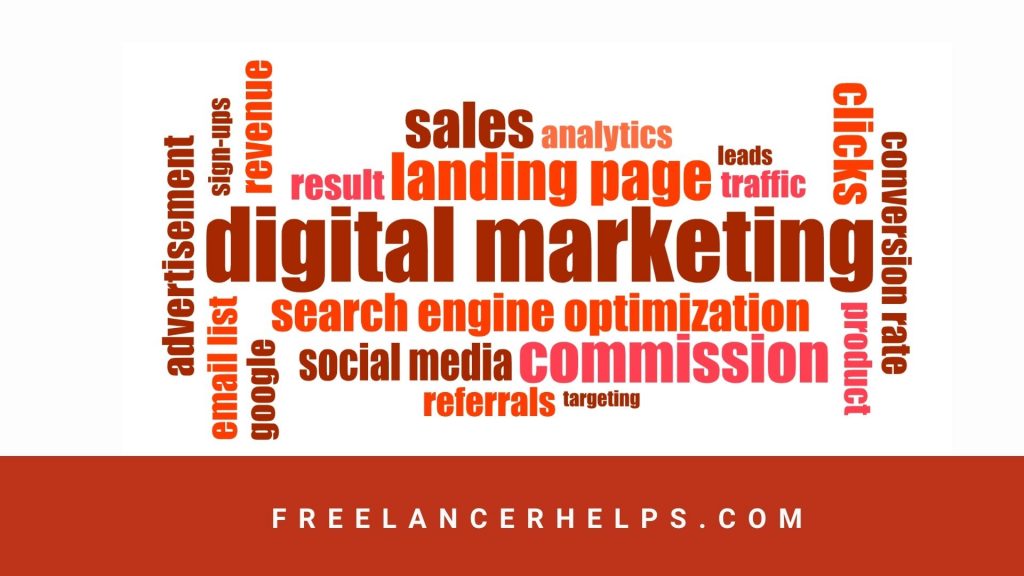What is Digital Marketing | Learn it in 5 Minutes : Undoubtedly, digital marketing is one of the most popular marketing systems in the world today. Because it is very popular among the younger generation and now it has become quite acceptable among the middle and older generation.
Marketers are now using digital marketing as a reliable channel to market their products and services. Digital marketing builds a good relationship with customers and consumers through electronic communication.
Due to advances in technology, the use of digital marketing, social media marketing and search engine marketing continues to grow.
Understanding customer behavior and what digital marketing is is essential for successful digital marketing. So let’s get to know all the details of digital marketing.

Technical marketing
Marketing is a volatile, volatile and dynamic business venture. The role of marketing has changed dramatically due to various crises and energy shortages, inflation, economic downturn, high unemployment, mortality, mortgage companies, terrorism and war and the impact of rapid technological change in some industries. Digital marketing has created a huge buzz in today’s world.
Digital marketing basically refers to the application of all marketing strategies across digital channels. This marketing system uses services and various sources such as SMS, search engine, email, website, social media and mobile devices to promote the product.
The “digital” nature of digital marketing has made it one of the most affordable ways to promote your business. The use of digital marketing depends on the marketing goals of a business organization.
In a word, digital marketing is the marketing of any product or service through the use of modern technology. Digital marketing relies heavily on the Internet, but includes the use of mobile devices, the display of advertising, and the use of all forms of modern media.
If you are new to digital marketing, this may seem a bit complicated to you
However, digital marketing is not different from our traditional marketing system in many ways.
This is because in both cases there is a need for businesses to build relationships with their customers. The main difference here is that the marketing channels are used by the business.
Think about the last important thing you bought, maybe you bought a house, hired someone to fix your roof, or changed the paper supplier in your office.
However, the first thing you should do is search the internet, learn more and find the best option for everyone.
Undoubtedly your final purchase decision is largely based on the advice of your friends or family and the value, features and benefits found from your research on the internet.
As you can see, most of our purchasing decisions are made online nowadays.
This is where the need for “digital marketing” works and it will take you one step further than traditional marketing systems in selling your products or services in a variety of ways.
The difference between conventional marketing and digital marketing systems
It is often seen that small businesses face a lot of complications with what kind of marketing to do, as their budgets will only expand to one or the other, not both.
Although decision making is not an easy task, many questions arise, such as – Which method of marketing will give me the most sales and profits? How do I know if my marketing is working? Who should I trust with my marketing? Should I do it myself? To illustrate this point, the use of print advertising in newspapers and magazines may be a common example of conventional marketing.
Flyers, TV or radio ads in the mailbox are also excellent examples of traditional marketing systems.
On the other hand, when a business invests in creating a website, advertising their branding and name through various social media like Facebook, Twitter and YouTube, this type of marketing strategy is called digital marketing.
Gradually we will learn more about it.
The benefits of digital marketing
1. You can target local customers as well as international customers. In addition to flaws, you can create promotional campaigns based on specific demographics, such as customer gender, location, age, and interests, which will make your business promotion more effective.
2. Digital marketing systems allow you to determine how your customers will receive products. Maybe when one person likes to read blog posts, another likes to watch YouTube videos and their personal favorite sales channel becomes “digital” marketing. Traditional marketing systems do not allow for personal preference. As a customer you have very little interest in this subject, you must not like unwanted mail or unwanted phone calls in the mailbox. From here, things get trickier, and this is where the true meaning of digital marketing comes in.
3. In digital marketing, you can build relationships with your customers through social media. On the other hand, in the traditional marketing system, there is no opportunity for this interaction.
4. Digital marketing is relatively affordable. Although a business has to invest a certain amount for online advertising, in reality this amount of investment or expenditure is much less than the conventional marketing system.
5. You can easily record data and results of your transactions. With Google Analytics and most social media channel tools you can test or review your campaign at any time.
You can see in real time what works or doesn’t work for your business online, and you can quickly adapt to improve each result.
6. Level playing field: With powerful digital marketing systems, your business can compete with any competitor regardless of size.
In traditional marketing systems, a small business competes with a relatively large business in the same field, but digital marketing has no effect on the size of the business. This means that even if you are a new entrepreneur, you can continue your marketing at a very low cost and successfully.
7. Real-time results: You don’t have to wait for a review of your business status or improvement, for example, you have to wait for a mail or fax every day to know the boost results of your business, it is definitely time. . Consuming and annoying. Digital marketing, on the other hand, lets you know your customers, maximum trading time, conversion rate, etc. with just one button.
8. A well-planned and effective targeted digital marketing campaign can deliver your product to the right customers at a much lower cost than conventional marketing methods. Through digital marketing channels, businesses display prices for products and services and make their prices very clear and transparent to their customers.
9. Brand Development: Brand development is basically a well-maintained and regulated website that can deliver significant amounts of value and lead. The same thing applies with e-mail marketing or social media channels. This means that you can technically develop a brand with very little effort.
10. Viral: The “Share” button used on your website, email and social media channels is beyond your comprehension how fast your business is spreading to others! Let’s say you have an average of 190 friends per Facebook user, with an average of 12% seeing their “liked” posts, literally bringing your business message to 15 new people.
Pool and push digital marketing
There are two main types of digital marketing, one of which is “pool” digi marketing. The purpose is to encourage consumers to come to you by visiting your business or making a call to action. Some common examples of pool digital marketing are websites and other internet based media. Pool marketing is often referred to as “inbound marketing”.
The second type of digital marketing is “push” digital marketing. It pushes marketing information directly to your customers. Common examples include SMS, email and RSS that target customers with customized messages. Push marketing can also be called “outbound” marketing.
Why digital marketing is important ?
The digital marketing target reaches the customer in a way that engages them in a way that has never been possible before. A strong digital marketing strategy can provide much higher return on investment than traditional marketing methods.
Today, with more than half of the world’s population regularly accessing the Internet, research suggests that the average person spends 8 hours a day online and this is a huge opportunity for any brand and business.
As the number of Internet-connected portable devices increases, this trend will not decrease but will continue to increase. A recent report found that global smartphone sales surpassed feature phone sales for the first time in 2013, and that’s about to happen.
Nowadays, digital marketing has started a new chapter which combines customization and wide distribution to achieve different marketing goals.
The constant development of digital marketing strategies has opened the door of possibilities for any brand and business organization. Here are some of them:
Branding: The digital marketing platform has brought to the fore an unimaginable opportunity to create its own image of any brand on the web, mainly due to its scope, presence and specific updates.
Integrity: The convenience of gathering information through just one link enables the entire customer base to reach specific business organizations in a broader and more customized way.
Usability: The digital marketing system is much more user-friendly, a customer can easily reach his desired product and needless to say, this user-friendly feature has further increased the acceptability of digital marketing.
Interactivity: Creating the possibility of conversation, creating a positive relationship between the seller and the customer, which is called interactivity.
Visual Communication: A marketer has access to a variety of image and video tools through digital marketing. Which helps a customer reach out to marketers and engage them in marketing.
A proper planning is essential for every job, just as there is a digital marketing plan for successful digital marketing.
A digital marketing plan is a strategic document that determines the current situation of a particular business organization, setting specific goals as well as various strategies and ways to implement them.
Responsibilities include monitoring digital marketing plans, time frames and control tools. One of the goals of a digital marketing plan is to discuss business entities and their surroundings.
Similarly, it helps to create a roadmap on how to manage the company’s marketing strategy, so that resources are spent properly and profitably. The steps of a digital marketing plan are as follows-
1. Situation analysis
2. Goal setting
3. Strategy
4. Action and control
Types of Digital Marketing
Currently digital marketing depends on the type of communication of the internet user. Digitl marketing is divided into the following sections based on the management and use of different types of digital marketing channels. These are basically different types of digital marketing, depending on the type of business or customer movement. Let’s take a look at these marketing-
Content Marketing –
Content marketing is one of the best marketing, although it is basically an indirect marketing process. Typically, merchants market their products through the promotion of their products, services or branding.
But when it comes to content marketing, you need to focus on promoting your “brand value” through relevant and relevant content.
Content marketing systems include a variety of content such as blogs, videos, social media posts, e-books, brochures, infographics, case studies and templates. Examples of popular content on the Internet.
In short, content marketing is about creating content to help your customers purchase their products and make decisions based on their needs and abilities.
Many say “Content is King”, content marketing builds customer confidence as well as brand awareness and ultimately leads to promising results.
By publishing high quality content you can establish authority in your business. A good quality content is more likely to be shared and referenced, which will spread your reputation among customers and different industries.
Another beneficial aspect of content marketing is that it builds good relationships with any other digi channel. That’s why good quality content should be the basis of your digitl marketing strategy.
For example, you can write good articles that can properly apply SEO keywords, say good Instagram and Facebook posts with links that can easily get customers to your website. Understand how effective content marketing is.
Search Engine Optimization (SEO)
Search engine optimization (SEO) in marketing has become known as the revolution of the last decade. For good reason, over 90% of people start their shopping experience with a simple online search on search engines like Google and Bing.
With SEO, you can rank on the search results page for your most relevant and searched keywords and in this process you can reach many potential customers.
After all, you would be surprised to know that over 63,000 searches are made every second on the Internet, and this is where the door of possibility opens.
An effective SEO strategy has been developed with a number of advanced technologies including keyword research, content creation, backlink building, website optimization.
There is even a specific subset called Local SEO, which helps their local clients focus on small business marketing.
One of the reasons SEO is so popular is because it is a highly effective form of inbound marketing. This means that instead of reaching customers, you are focusing on bringing customers to your website through search engines and it is seen that these customers are often already searching for a purchase.
SEO helps you optimize your website and online presence, allowing you to drive high conversion rates as well as high quality website traffic.
Search Engine Marketing (SEM)
Search engine marketing or SEM is often confused with SEO because the two have a lot in common. Both work with search engines like Google or Bing. However, there are some important differences between these two types of digi marketing.
SEO helps you automatically rank for your target keywords, while increasing your website traffic from search engines through search engine marketing or providing SEM. “Bing Ads” and “Google AdWords” are among the most popular search engine marketing.
SEM helps you place your ad on any search results page. These ads look like automatic search results on Google, with only one ad “banner” attached.
These ads first appear on any search results page, giving your website unimaginable visibility and traffic.
Digital marketers prefer SEM because it is much easier to create accurate ads based on keywords and searcher position.
This means you can link to your ad based on a specific population or number. You can even take it one step further and target competing keywords, which makes it possible for you to “steal” some website traffic from competing businesses. There is nothing to panic about when it comes to “stolen” traffic, which is basically a hoax of search engine algorithms.
One thing to keep in mind is that search engine marketing (SEM) is by no means an alternative to search engine optimization (SEO). To get more traffic, you need to combine these two strategies.
Email marketing
Email marketing is a form of digital marketing where information / messages about a product or service are sent to the customer via email.
Email marketing is one of the oldest and simplest digital marketing processes. But now it is recognized as a very modern and productive marketing.
In the email marketing system, marketers use email to build relationships with their potential and existing customers, which basically helps them build leadership and ensure their conversions.
Email marketing was once a bit complicated, but now with the advent of various tools, email marketing has become one of the most sought after and effective digital marketing methods.
Because most of these tools are free and you can generate traffic at very low cost through specific landing pages and subscription forms.
Social Media Marketing (SMM)
As the name implies, social media marketing (SMM) is basically marketing your business using the power or advertising of your product on social media platforms.
Social media has dominated the digital world for the past decade, attracting and attracting billions of users from all over the world. And it has served as a source of unimaginable amount of traffic to any website.
You can see the number of daily users on three popular social networking platforms.
Facebook – 1.66 billion active users daily
Twitter – 330 million monthly active users
Instagram – 500 million active users daily
The key to success in social media marketing (SMM) is to create content that can be shared.
Every social media network has sponsored posts and paid ads, so you don’t have to spend too much.
Pay Per Click (PPC)
Pay Per Click, also known as PPC, is one of the most common forms of digital marketing.
This is basically based on a specific ad model, where you only pay for the clicks you receive in your ad.
PPC is usually covered by search engine marketing, when it is advertised in the SERP, but in some cases PPC may extend to affiliate marketing.
In this case the amount of expenditure is very low. If a customer clicks on your ad, you have to pay a minimum price. If someone doesn’t click on it, you can’t give anything away.
This makes it attractive for small business owners on a limited budget. However, it is difficult to estimate how much you will need to shell out at the end of the month.
Affiliate Marketing
Affiliate marketing is a very smart type of digital marketing.
In an affiliate marketing system, basically, an authorized affiliate marketer sells other people’s products to the audience.
If someone purchases something from you after linking to the authorized person’s site, you will have to pay a certain amount of money or commission for the authorized person’s reference.



